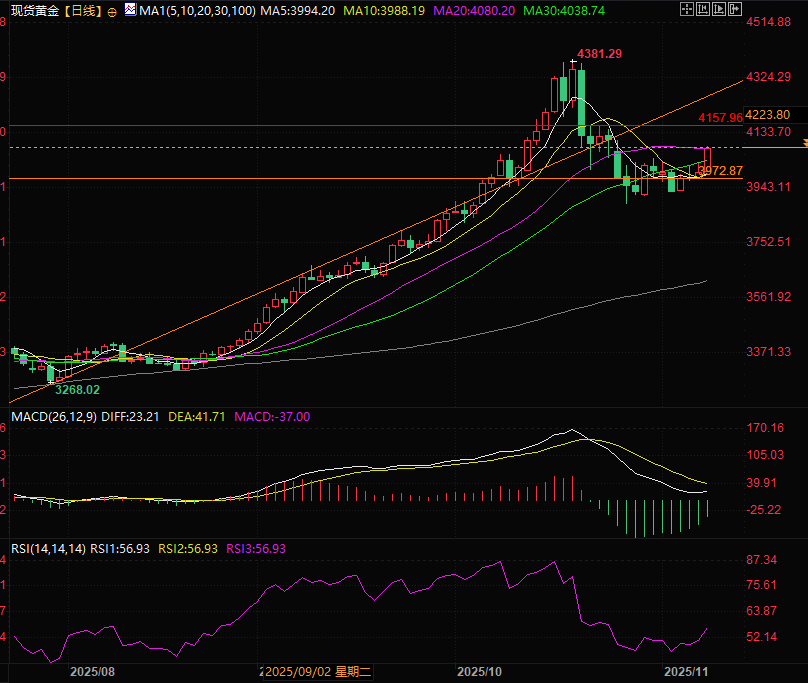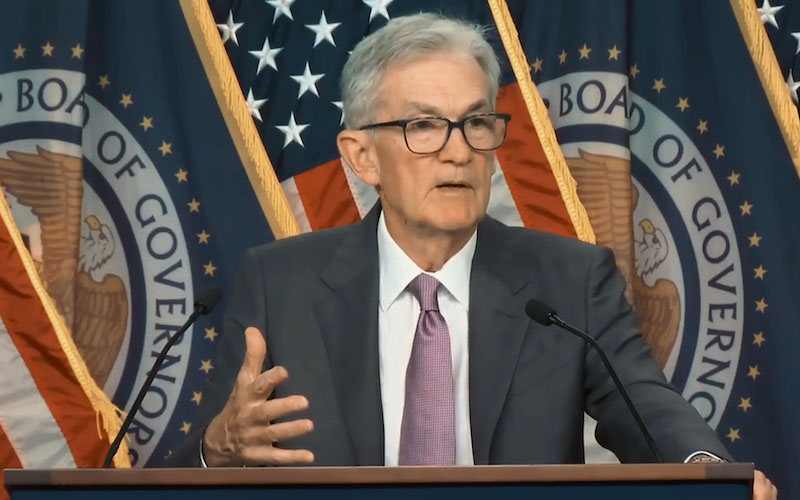When positive news for gold prices clashed with technical resistance, the battle between bulls and bears behind the gold price surge...
2025-11-10 20:11:36

Big data reveals a surprising trend, indicating a deterioration in consumption patterns.
A new survey released by the University of Michigan last Friday showed that, under the dual pressures of government shutdown and rising prices, the consumer confidence index plummeted to 50.3 in November, the lowest level since 2022.
Respondents holding more equity assets were relatively more optimistic, a phenomenon that highlights the "K-shaped" characteristic of the recovery—the gains from the market rally are mainly concentrated in wealthy households.
University of Michigan professor Betsy Stevenson, a former member of President Obama's Council of Economic Advisers, stated bluntly last Friday: "Hiring activity has slowed significantly. It's still relatively stable for those already employed, but the situation for the unemployed has clearly worsened compared to a year or two ago."
Leading companies have announced layoffs, with the scale of layoffs reaching a new high.
A report released by Challenger shows that U.S. companies announced over 153,000 layoffs in October, marking the worst month for the same period since 2003. The firm attributes the surge in layoffs primarily to cost-control measures by companies, the substitution effect of artificial intelligence technology, and a correction of over-hiring during the pandemic.
Looking at the whole year, companies have disclosed layoffs totaling over 1.1 million employees so far, a 44% surge compared to the total for 2024. The technology and retail sectors have been hit hardest, with leading companies such as Amazon (AMZN), Target (TGT), and UPS all announcing layoffs.
Job growth is lower than in the previous period, and white-collar jobs are shrinking significantly.
Data from payroll agency ADP shows that private sector employers added 42,000 jobs in October, marking the first monthly increase since July, but still significantly below market expectations for the earlier part of the year. Job growth was primarily driven by the trade, transportation, and utilities sectors, while the professional services and information industries, a core driver of white-collar employment, experienced a noticeable contraction in employment.
Fundstrat economic strategist Hardik Singh noted in a report last Thursday: "ADP private sector employment data showed modest job growth last month, but these jobs were not concentrated in artificial intelligence-related fields—a rather unexpected result given that investors are generally betting that breakthroughs in artificial intelligence technology will become the core engine of economic growth."
Singh further analyzed that the more crucial insight is that while corporate profits benefit from AI-driven productivity gains, workers do not share in the benefits: "When market participants are worried about the risk of unemployment, the stock price performance near historical highs is unlikely to generate substantial optimism."
Stevenson emphasized: "The combination of high inflation and a slowing labor market constitutes the core trigger for economic turmoil. No one wants to be in an economic environment where a small elite continues to benefit while the vast majority can barely maintain their current standard of living."
With the government shutdown nearing its end, the Federal Reserve may begin a policy shift.
"The Fed currently lacks comprehensive data support... but it can already sense the weakness in the labor market," said Yung-Yu Ma, chief investment strategist at PNC Asset Management Group.
He characterized the private sector data as "mixed," adding, "In the absence of reliable data anchors, policy decisions will face significant challenges."
Centrist senators supported the agreement to restore some federal departments to operation and pay federal employees' salaries, while some departments received budget appropriations up to January 30, and the rest received appropriations for the entire year.
Weng Yuyu pointed out that the Federal Reserve may interpret the recent trend as a clear signal of "weakening labor market," and once the government shutdown ends and data collection resumes, the window for interest rate cuts is expected to gradually open.
Based on a comprehensive analysis of various data, it is not difficult to conclude that although the current labor market remains superficially stable, its vitality has significantly declined compared to the same period last year—employees tend to maintain their current positions, companies are becoming more cautious in their recruitment efforts, and overall market confidence is gradually weakening.
The market has reached a consensus on this expectation. According to CME Group's FedWatch tool, as of Monday, traders had priced in a 63% probability of a December rate cut.
San Francisco Fed President Mary Daly and St. Louis Fed President Alberto Musshalam will speak later this week, and traders are closely watching for clues about inflation trends and policy direction. Recent data from the Cleveland Fed shows that long-term inflation expectations are holding steady around 3.5%, meaning that despite slowing economic growth, price pressures have not eased.
The Federal Reserve has kept interest rates unchanged since September, but weak employment data and declining business confidence have prompted market speculation that policymakers may ease monetary conditions to support economic demand in early 2026.
Technical Analysis:
The four-hour chart for spot gold shows that the price has reached its target for the current phase after breaking out of the trading range. 4150 is the recent resistance level, while 4025 is the support level, representing the neckline of the breakout.

(Spot gold 4-hour chart)
As can be seen from the daily chart of spot gold, the price of gold is being suppressed by the 20-day moving average. However, if the price of gold can continue to stay above the 30-day moving average (around 4040), the 20-day moving average will turn upward, and all moving averages will return to a bullish alignment.
However, it is worth noting that before 4160, there was a huge amount of trapped capital in ETFs, and this range will become an important resistance level for gold prices.

(Spot gold daily chart, source: FX678)
At 20:05 Beijing time, spot gold was trading at $4,085 per ounce.
- Risk Warning and Disclaimer
- The market involves risk, and trading may not be suitable for all investors. This article is for reference only and does not constitute personal investment advice, nor does it take into account certain users’ specific investment objectives, financial situation, or other needs. Any investment decisions made based on this information are at your own risk.





















